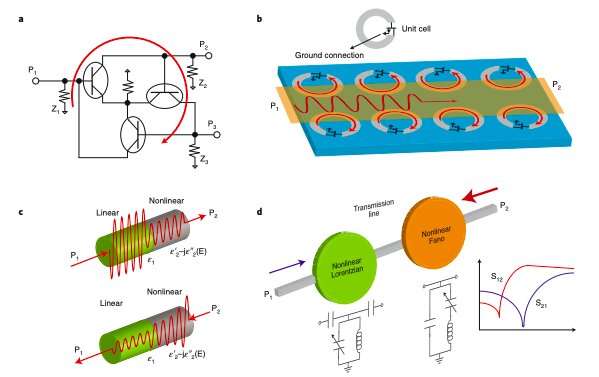May 26, 2020 feature
Reviewing recent advances in the development of non-reciprocal electronics

The propagation of both light and sound waves is reciprocal in nature. In other words, light and acoustic waves travel forward and backward in the same way.
Breaking this reciprocity in wave propagation can enable the development of what are known as 'one-way' electronic devices, which include isolators and circulators. These devices have shown great promise for a variety of applications, for instance, in communications, radar technology and quantum computing.
Researchers at Columbia University have recently carried out a study reviewing advances in the development of non-reciprocal electronic devices. Their paper, published in Nature Electronics, offers a general summary of isolators and circulators introduced over the past few years, outlining some of their characteristics, advantages and limitations.
"Isolators protect higher power transmitters in base stations from reflections from the antenna," Harish Krishnaswamy, one of the researchers who carried out the study, told Phys.org. "On the other hand, circulators are used in radars and emerging full-duplex wireless transceivers to allow a transmitter and a receiver to communicate at the same time with the same antenna. Both of these components also find application in emerging quantum computers, to allow the measurement of a qubit without disturbing it."
Most existing non-reciprocal devices are made of magnetic materials, such as ferrites, which are known to lose their reciprocity when an external magnetic field is applied to them. Ferrites, however, can be difficult or impossible to integrate within low-cost semiconductor manufacturing processes.
As a result, magnetic components for non-reciprocal devices can be quite bulky and expensive, which ultimately prevents their widespread use. In their review paper, Krishnaswamy and his colleagues discuss these challenges at length, outlining some of the strategies to decrease the costs of 'one-way' devices proposed by research teams worldwide.
"Over the past several decades, there has been a lot of interest in breaking reciprocity and building non-reciprocal components without the use of magnetic materials," Krishnaswamy explained. "It has been shown that applying a temporal modulation to an electronic circuit can lead to the breaking of reciprocity."
Krishnaswamy and his research group have been investigating non-reciprocal components, including both isolators and circulators, for several years now. Over the past five years, their work specifically focused on components based on switching circuits, which can operate via a clock-type mechanism.
"We reported our first discovery of this effect in 2016 in Nature Communications, which was the first circulator-on-a-chip," Krishnaswamy said. "We followed that up with another paper in Nature Communications in 2017, reporting the first circulator-on-a-chip at millimeter-wave frequencies. Since then, we have been working on improvements that push the limits of various performance metrics, including loss, power handling and bandwidth."
The researchers' new paper reviews the history of non-reciprocal electronics, from early work conducted in the 1950s up to recent studies carried out by both them and other research groups. Their study focuses on approaches for developing one-way' devices based on temporal modulation of permitivity and conductivity, which have been found to be particularly promising.
In their paper, Krishnaswamy and the other authors also highlight the potential of hybrid acoustic-electronic components, which could help tackle and overcome some of the limitations of non-reciprocal magnetic parts. These hybrid components have a number of possible applications. For instance, they could enable the creation of radar systems that can both transmit and receive information, high-power transmitters for communications, and more efficient wireless radios.
Finally, the researchers' discuss the potential of some of these electronic components in the development of quantum computers and other quantum technologies, while also touching on some of the challenges that need to be overcome before these devices can be implemented on a large-scale. Overall, their paper offers an in-depth summary of advances in this particular research field, which could serve as guidance for other teams trying to develop non-reciprocal technologies.
"Over the past five years, my group's work has primarily focused on integrated non-reciprocal components for communication and radar devices," Krishnaswamy said. "Moving forward, we will be shifting our focus to cryogenic non-reciprocal components for quantum computing applications."
More information: Aravind Nagulu et al. Non-reciprocal electronics based on temporal modulation, Nature Electronics (2020). DOI: 10.1038/s41928-020-0400-5
© 2020 Science X Network




















